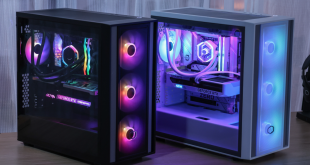Today we are going to throw our rulebook out the window … as our regulars know we normally test products with partnering equipment in the same price range.
Thermaltake are keen to promote the cooling capabilities of the chassis design, so we decided to really take them at face value and included some of the highest end hardware we have in our labs.
You can be sure if it manages to work with these components it will work with any system.
The test build today will comprise of the following components:
Intel Core i7 980X
Intel DX58SO Motherboard
Thermaltake Frio Cooler (2 120mm Thermaltake fans on low)
6GB of DDR3 1600mhz Ram.
Thermaltake Toughpower XT 775W Power Supply
nVidia GTX480
Intel 80GB SSD Raid 0
Windows 7 Ultimate Edition 64bit
Thermal Diodes
Raytek Laser Temp Gun 3i LSRC/MT4 Mini Temp
Digital Sound Level Noise Decibel Meter Style 2
Firstly let us have a look at the chassis design and airflow, as it comes ‘out of the box'.
At the front we have a 120mm fan which is in an intake position. This forces cool air in from the front, over the motherboard and is then sucked upwards by the 200mm and 120mm fan at the rear of the case in the top positions. This is pretty much a traditional cooling methodology which works well.
We have placed thermal diodes in 5 case positions – 1; top optical drive bay position. 2; hard drive position. 3; top area between CPU and fan exhaust position. 4; above PSU, graphics card (s) area. 5; motherboard central ‘dead zone' area.
We test with our Intel 980X CPU at reference clock speeds and voltages. Nothing else is overclocked. Room Ambient temperatures in our labs are maintained at a constant 25c with air conditioning. There is no side panel case fan installed. Load is measured by running Cinebench R11.5 in a loop with Furmark, worst temperatures are recorded through a duration of 20 minutes.
We can see that Diode 5 and Diode 4 temperatures rise a few degrees after our load tests and we can see that Diode 2 stays at the same temperature, with the pure cool air flowing directly over it.
When then installed a Noctua 120mm fan into the side panel to see if it would have an impact on the GPU and system temperatures.
When comparing with the temperatures from before, the extra side panel fan has reduced temperatures on our reference GTX480 by 4c under load. Other benefits include the Diodes in this area dropping a few degrees, memory also is aided a little by increased airflow with temperatures dropping by a single degree.
Now we want to see if we can overclock the 980x processor. We raise core voltage slightly (1.35) and increase the clock speeds to 4.35ghz.
The combination of the excellent Frio cooler and the heavy airflow throughout the chassis manage to help our 980x well within acceptable limits and we are really impressed that such a modestly priced chassis can handle these components with relative ease.
 KitGuru KitGuru.net – Tech News | Hardware News | Hardware Reviews | IOS | Mobile | Gaming | Graphics Cards
KitGuru KitGuru.net – Tech News | Hardware News | Hardware Reviews | IOS | Mobile | Gaming | Graphics Cards







